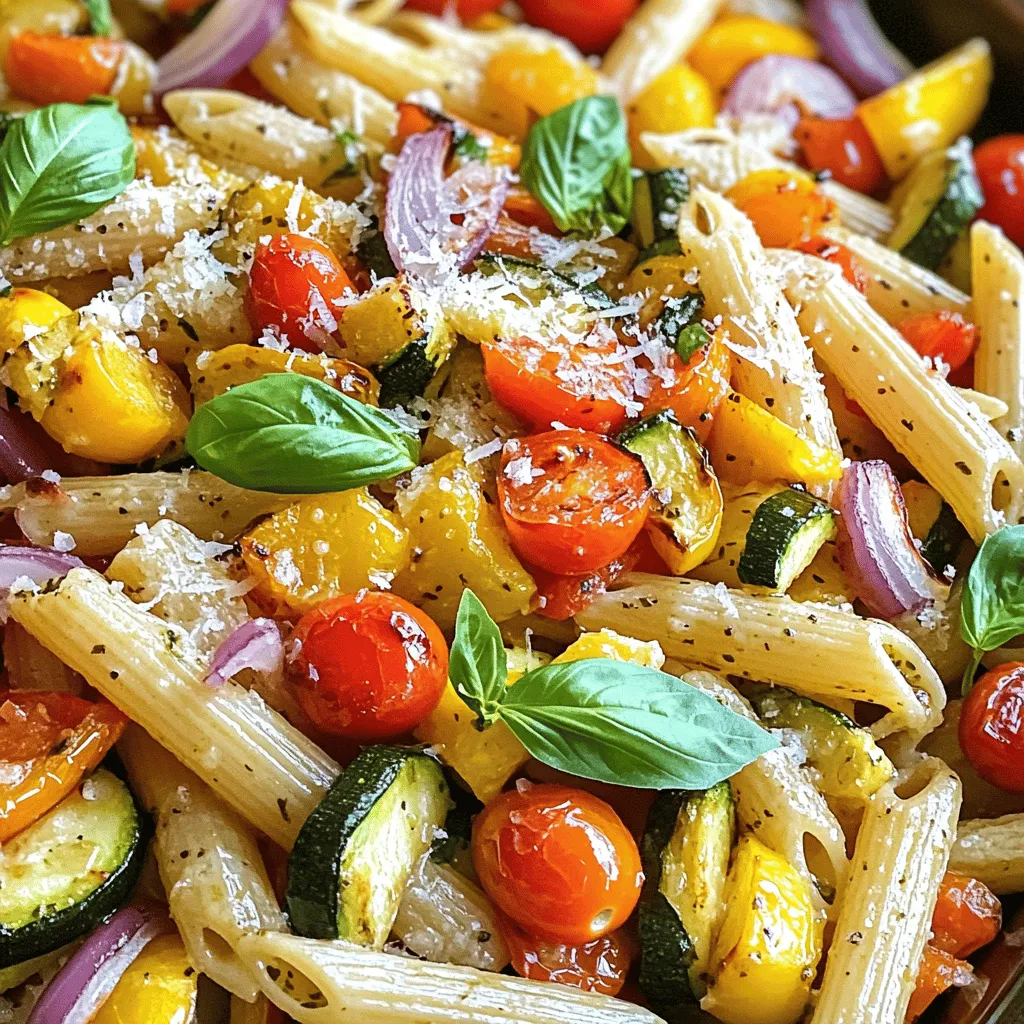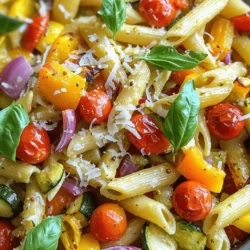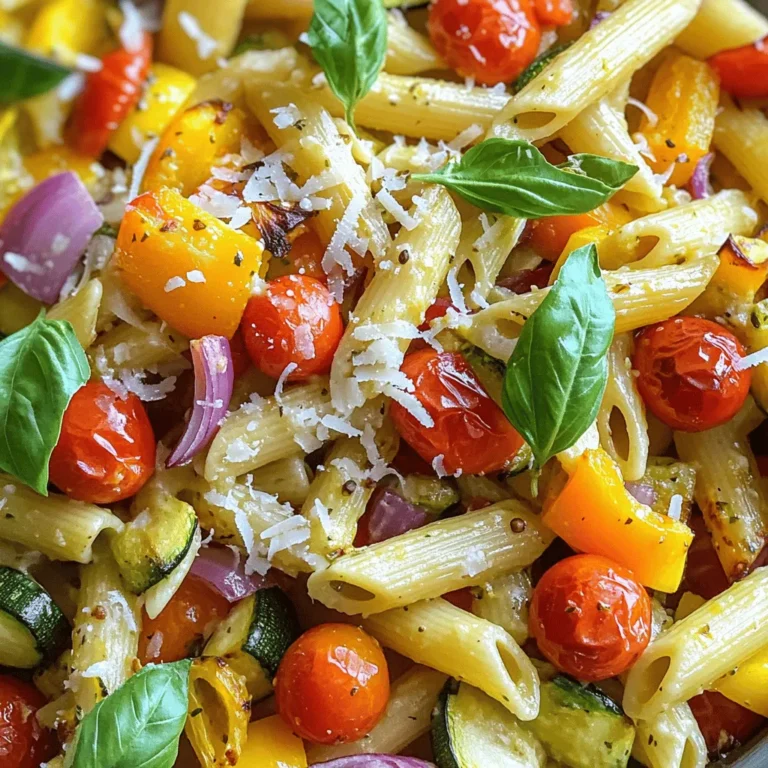Looking for a tasty, simple dinner? Roasted Vegetable Pasta is your answer! This dish brings together seasonal veggies and your choice of pasta for a quick meal that packs a flavorful punch. In this guide, I’ll share tips on selecting fresh ingredients, step-by-step cooking instructions, and creative variations. Get ready to impress your family with a dinner everyone will love! Let’s dive into this easy recipe.
Ingredients
Vegetable Selection
For roasted vegetable pasta, I like to use:
– 2 cups assorted vegetables (zucchini, bell peppers, red onion, cherry tomatoes), chopped
– 3 cloves garlic, minced
When picking vegetables, choose what’s in season. Seasonal produce tastes better and is often cheaper. Look for colorful options. Fresh, firm vegetables yield the best flavor. If you can, visit a local farmer’s market. It’s a great way to find fresh ingredients.
Pasta Options
I recommend using these types of pasta:
– 8 ounces pasta (penne or fusilli preferred)
Penne and fusilli hold sauce and roasted veggies well. If you’re gluten-free, consider these alternatives:
– Gluten-free pasta made from rice or quinoa
– Chickpea or lentil pasta for extra protein
These options work great and still taste delicious.
Seasonings and Add-ins
For seasoning, I use:
– 2 tablespoons olive oil
– Salt and pepper, to taste
– 1 teaspoon Italian seasoning
These spices bring out the flavors of the vegetables. You can also add optional garnishes like:
– 1/4 cup Parmesan cheese, grated (optional)
– Fresh basil leaves for garnish
These add a nice touch and enhance the dish’s look. If you want more flavor, try fresh herbs or a squeeze of lemon juice. Enjoy experimenting!
Step-by-Step Instructions
Preparation
First, you need to preheat your oven to 425°F (220°C). This high heat makes the vegetables caramelize nicely. While the oven heats, grab a large baking sheet. Spread your chopped vegetables on the sheet. I like to use a mix of zucchini, bell peppers, red onion, and cherry tomatoes.
Next, add minced garlic, olive oil, salt, pepper, and Italian seasoning to the vegetables. Toss everything until well-coated. This step adds great flavor to your roasted vegetables.
Roasting the Vegetables
Now, place the baking sheet in the oven. Roast the vegetables for about 20-25 minutes. They should be tender and slightly caramelized when done. Stir the vegetables halfway through to ensure even cooking. This way, every bite will be tasty.
Cooking the Pasta
While your veggies roast, bring a large pot of salted water to a boil. Add your pasta, like penne or fusilli. Cook it according to the package instructions until it reaches al dente. This means it should be firm to the bite.
Don’t forget to reserve about 1/2 cup of the pasta water before draining the pasta. This water helps adjust the sauce later.
Combining Ingredients
In a large bowl, mix the roasted vegetables with the cooked pasta. If the mix seems dry, add some reserved pasta water. This helps create a lovely sauce that clings to everything.
If you want, sprinkle grated Parmesan cheese on top and toss again. This adds a rich flavor. Serve hot, and don’t forget to garnish with fresh basil leaves for a bright finish.
Tips & Tricks
Perfecting the Roast
To achieve caramelization, you need high heat and some space. Spread your vegetables out on the baking sheet. If they are too close, they will steam instead of roast. Use a good amount of olive oil to help them brown. Stir them halfway through to ensure even cooking.
If your veggies seem soggy, try a couple of tricks. Increase the oven temperature slightly. This helps moisture escape. You can also roast them for a longer time. Keep an eye on them to avoid burning. Adding a sprinkle of salt can help draw out extra moisture, too.
Pasta Cooking Tips
Common mistakes with pasta include overcooking and not salting the water. Always check the package for cooking time. Aim for al dente, which means firm to the bite. This keeps the pasta from getting mushy when mixed with the roasted veggies.
Flavoring the pasta cooking water is key. Use a generous amount of salt. It should taste like the sea. This step adds flavor to the pasta itself, which enhances the whole dish.
Serving Suggestions
For sides, a simple green salad pairs well. It adds freshness and crunch. Garlic bread is another great option. It soaks up any extra sauce from the pasta.
Serve the dish hot for the best taste. Garnish with fresh basil leaves. This adds color and aroma. For presentation, use a large bowl. Mix everything well before serving. This way, the colors and textures shine through.

Variations
Seasonal Variations
You can change your roasted vegetable pasta based on what’s in season. For spring, use asparagus and peas. In summer, try zucchini and bell peppers. Fall is great for butternut squash and Brussels sprouts. In winter, root veggies like carrots and parsnips shine.
Also, don’t stick to just one pasta shape. Use penne, fusilli, or even spaghetti. Each shape holds sauce and flavors differently, making each meal unique.
Dietary Adjustments
To make roasted vegetable pasta vegan, skip the cheese. You can use nutritional yeast for a cheesy flavor. It’s a great source of vitamins and adds a nice touch.
If you want more protein, add chickpeas or lentils. They mix well with all the roasted veggies. You could also add grilled chicken or shrimp for a non-vegan option.
Flavor Infusions
Herbs and sauces can boost the flavor of your dish. Try fresh basil, oregano, or thyme for herbs. You can also drizzle balsamic glaze or lemon juice for extra zest.
If you want to switch up the cheese, use feta or goat cheese. They add a tangy taste that pairs well with roasted veggies. Get creative and make the dish your own!
Storage Info
Storing Leftovers
To keep your roasted vegetable pasta fresh, follow these tips:
– Refrigerating: Place leftovers in an airtight container. They can stay in the fridge for up to three days.
– Freezing: For longer storage, freeze portions in freezer-safe bags. Squeeze out the air to avoid freezer burn. It can last up to three months.
When you reheat, make sure to use low heat. This helps keep the pasta and veggies from becoming mushy. Add a splash of water or olive oil to bring back some moisture. Stir often for even warming.
Meal Prep Ideas
Meal prep is fun and easy with this recipe. You can prepare the components ahead of time:
– Vegetables: Chop your veggies a day before. Store them in the fridge in a sealed bag.
– Pasta: Cook the pasta ahead and keep it in a separate container. This prevents it from getting soggy.
For ready-made meal storage, pack the pasta and vegetables in individual containers. This way, you can grab a healthy meal anytime. Just reheat and enjoy!
FAQs
How long does Roasted Vegetable Pasta last in the fridge?
Roasted Vegetable Pasta lasts about 3 to 5 days in the fridge. It is best to store it in an airtight container. Make sure the dish cools down before sealing. To enjoy its freshness, eat it within this time frame. If you want to keep it longer, consider freezing it.
Can I use frozen vegetables for this recipe?
Yes, you can use frozen vegetables for this recipe. However, frozen veggies may not roast the same way as fresh ones. They often have more water. This can lead to a softer texture. To improve results, thaw them first and pat them dry. This helps reduce moisture and allows for better roasting.
What are some ways to customize this recipe?
You can customize this recipe in many ways. Here are some ideas to get you started:
– Add protein: Consider chicken, shrimp, or chickpeas for extra nutrition.
– Change the veggies: Use seasonal vegetables like asparagus or broccoli.
– Experiment with sauces: Try pesto, marinara, or a creamy sauce for added flavor.
– Spice it up: Add red pepper flakes for a hint of heat.
How can I make this dish gluten-free?
To make this dish gluten-free, choose gluten-free pasta. Many brands offer a variety of shapes, such as penne or fusilli. Be sure to read the labels to find one that suits your taste. This way, you can enjoy the roasted vegetable pasta without any gluten.
This blog post covered how to make a delicious Roasted Vegetable Pasta. We explored selecting fresh veggies, choosing the right pasta, and using herbs for flavor. I shared step-by-step cooking instructions, tips for perfecting the dish, and variations to keep it exciting. Storing the leftovers and meal prep ideas help make this dish easy to enjoy later.
Remember, cooking can be flexible. Feel free to experiment and make it your own. Enjoy your cooking journey!


